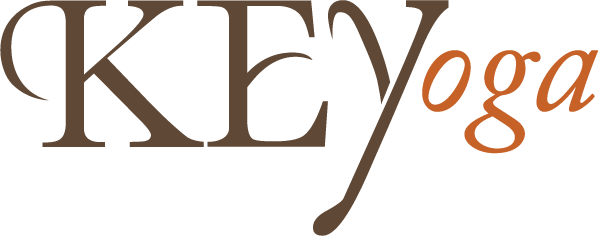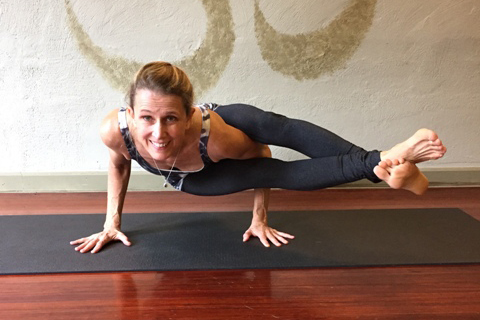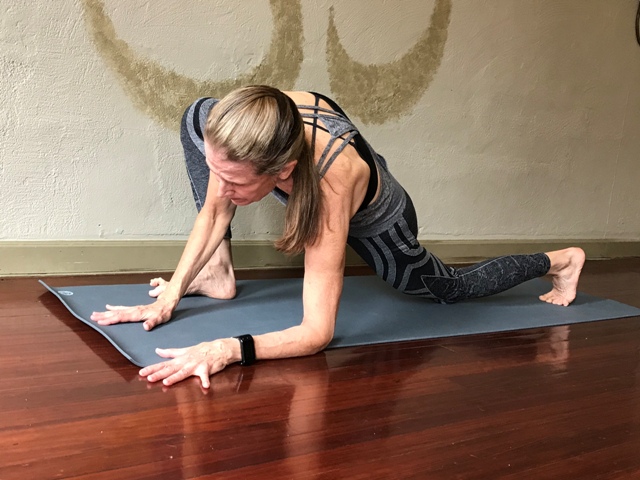I don’t recommend Legs-Up-the-Wall Pose as an alternative for Headstand or Handstand. The energy of these poses is very different.
A Practice to Boost Your Immune System
Hanumanasana or Front Splits
If you don’t like doing a full split because it just feels too intense, or you are too far away from the floor and you feel unstable and worried about tipping over and tearing something (a legitimate concern!) there are some modifications that can help you get there by reducing the discomfort of the full pose.
Revolved Side Angle Pose
Basic Sequencing for Revolved Side Angle Pose.
Revolved Side Angle or Parivrtta Parsva Konasana
Revolved SIde Angle
Parivrtta means revolved, turned round or back.
Parsva means side or flank.
Kona is an angle.
This is revolved side angle pose. It is a deep twisting posture that forms the foundation of many other twisting poses such as Parsva Bakasana, Side Crow and Eka Pada Koundinyasana I, a twisting arm balance. As we play with this pose this month, we will see where it leads us.
Parivrtta Parsva Konasana looks like Side Angle Pose with a twist, however, it is more related to Warrior I as the hips are facing the front leg, rather than turned open. It is a harder twist than Revolved Triangle Pose because of the position of the bent knee. The bent knee locks the hips in and restricts the twisting action in the lower back. In Revolved Triangle Pose, the twist is more evenly spread over the length of the spine. It is for this reason that Revolved Side Angle Pose can be therapeutic for the low back. But, it is also a caution to allow the spine to twist organically and not to try to force the twist. We will use other more open twists to prepare the body to come into Revolved Side Angle Pose.
The nature of twisting poses is that they change energy. If you are feeling stuck and lethargic, twists can help you get unstuck and energize you. On the other hand if you’re feeling wound up, twists can release energy and calm you down.
The thing about twists, however, is that when we run into difficulty in this pose we literally run into our self. Our own body gets in our way. How do we sit with the energy of that? What does it bring up for us? Does the judge or critic show up? Do we get mad or frustrated with ourselves? Do we try to use our arms for leverage and try to force ourselves into some external, or preconceived idea about ourselves? This is the interesting, inner work of the pose.
Pay attention to your breath while practicing Parivrtta Parsva Konasana. We generally use an exhalation to come into a twist and an inhalation to come out. Once you are in the pose notice your breath. It will be a little more restricted , but can you still breathe easily?
Poses for the Month of December - The Year in Review
2019 Poses in Review
The time between Thanksgiving and New Year’s are so jam packed and busy, I often feel compelled to teach restorative poses just so people can have a few minutes of relaxation. That doesn’t mean that the entire class will be restorative, it just means that we might start or end with a restorative pose or two. In the middle, I plan on reviewing the poses that we went over this year. Here they are in the order in which we did them:
January – Sarvangasana or Shoulder Stand
Read about Shoulder Stand here.
February – Sirsasana I or Head Stand on forearms
Read about Head Stand here.
March – Navasana or Boat Pose
Read about Boat Pose here.
April – Bakasana or Crow
Read about Crow Pose here.
May – Svarga Dvijasana or Bird of Paradise
Read about Bird of Paradise here.
June – Hanumanasana or Split
Read about Split here.
July – Parivrtta Parsva Konasana or Revolved Side Angle Pose
Read about Revolved Side Angle Pose here.
August- Visvamitrasana or Side Plank with lower leg lifted
Read about Visvamitrasana here.
September – Urdhva Dhanurasana or Wheel
Read about Wheel here.
October – Prasarita Padottanasana to Sirsasana II or Wide Leg Forward Fold to Tripod Head Stand
Read about the transition from Wide Legged Forward Fold to Headstand here.
November – Astavakrasana or Eight Crooked Places Pose
Read about Astavakrasana here.
December – I hope you enjoy this year in review! Also, if you have any requests for poses that you would like to work on next year, let me know in the comments below.
Lizard Lunge as a preparation for Astavakrasana
Continuing with postures in the sequence for Astavakrasana, let’s look at Lizard Lunge.
In order to be able to do Astavakrasana you have to be able to get your knee onto the back of your arm when you are in a seated position. In Lizard Lunge, you can see whether or not your shoulder is below your knee.
In this pose, the back leg is straight and the front leg bent with the shin perpendicular to the floor. If you can easily get both forearms evenly on the ground, then chances are that you have the flexibility to do Astavakrasana.
In the beginning you start with your hands on the floor,
eventually lowering your elbows to blocks and finally to the floor. It is harder to lower the inside elbow to the floor.
It is important to lower them both evenly. You may have to back up until you are able to achieve this. This may take a while. If you are interested in doing Astavakrasana, you might want to practice Lizard Lunge every day until you can easily get your elbows to the floor. This practice could unlock other poses for you as well such as Warrior I, Pigeon and Split.
In some of these photos, you can see that my back knee is on the floor. In the beginning, you might need to bend your back leg. Eventually, you may be able to keep the knee lifted and the back leg straight.
It is also important to maintain the length on the front body. Your torso will round if you are reaching too hard to get the elbows to the floor. Keep pressing down into the hands or forearms and lengthen your collar bones forward. Draw your shoulder blades towards each other and down your back towards your waist rather than away from each other and down towards the floor. As you would in Caturanga, don’t drop your head. Keep your neck in line with the spine and the back of your head level with your upper back.
You may be tempted to let the front ankle roll out. Some call this “Broken Pigeon”.
This often happens in the desire to get the elbows to the floor. This could be a good variation when you are working towards poses with the legs externally rotated such as Pigeon or Seated Cobbler’s Pose. But for now we are working on our ability to fold forward with one knee bent into our chest as in Marichyasana I.
For this pose, I prefer keeping the weight pressing down onto the inner edge of the foot and keeping the ankle straight. If you need some play, it is better to let the knee and foot rotate out a few degrees, but I would only do this if I could not get my hands to the floor, not to get my elbows to the floor. Be patient. Don’t force the stretch.
The next step would be to come into Eka Hasta Bhujasana, or One Arm Leg Pressure Pose.
And from there into Astavakrasana
Continuing with postures in the sequence for Astavakrasana, let’s look at Lizard Lunge.In order to be able to do Astavakrasana you have to be able to get your knee onto the back of your arm when you are in a seated position. In Lizard Lunge, you can see whether or not your shoulder is below your knee. In this pose, the back leg is straight and the front leg bent with the shin perpendicular to the floor. If you can easily get both forearms evenly on the ground, then chances are that you have the flexibility to do Astavakrasana.In the beginning you start with your hands on the floor, eventually lowering your elbows to blocks and finally to the floor. It is harder to lower the inside elbow to the floor. It is important to lower them both evenly. You may have to back up until you are able to achieve this. This may take a while. If you are interested in doing Astavakrasana, you might want to practice Lizard Lunge every day until you can easily get your elbows to the floor. This practice could unlock other poses for you as well such as Warrior I, Pigeon and Split. In some of these photos, you can see that my back knee is on the floor. In the beginning, you might need to bend your back leg. Eventually, you may be able to keep the knee lifted and the back leg straight. It is also important to maintain the length on the front body. Your torso will round if you are reaching too hard to get the elbows to the floor. Keep pressing down into the hands or forearms and lengthen your collar bones forward. Draw your shoulder blades towards each other and down your back towards your waist rather than away from each other and down towards the floor. As you would in Caturanga, don’t drop your head. Keep your neck in line with the spine and the back of your head level with your upper back.You may be tempted to let the front ankle roll out. Some call this “Broken Pigeon”.This often happens in the desire to get the elbows to the floor. This could be a good variation when you are working towards poses with the legs externally rotated such as Pigeon or Seated Cobbler’s Pose. But for now we are working on our ability to fold forward with one knee bent into our chest as in Marichyasana I.For this pose, I prefer keeping the weight pressing down onto the inner edge of the foot and keeping the ankle straight. If you need some play, it is better to let the knee and foot rotate out a few degrees, but I would only do this if I could not get my hands to the floor, not to get my elbows to the floor. Be patient. Don’t force the stretch.The next step would be to come into Eka Hasta Bhujasana, or One Arm Leg Pressure Pose. And from there into Astavakrasana
Prep for Astavakrasana
Preparing for Astavakrasana with Side Angle Pose
Why you should never do Side Angle Pose with your elbow on your knee.
I am not a fan of doing Side Angle Pose with your elbow on your knee. I prefer putting your hand on the floor or on a block. There are always exceptions and I understand that for some people that may be the best variation.
See how the lower shoulder is collapsed as I rest my weight into that elbow instead of lifting up off it?
However, the primary reason I don’t recommend the bent elbow version of this pose is because when students put their elbow on their knee in Side Angle, there is a tendency to collapse into that bottom shoulder.
They can be made aware of that and they can learn to press their elbow into their knee and open the chest and collar bone on that lower side, but that action is often not taught. It is much more natural to press down into the bottom hand when it is on the floor or on a block. But still, that action of opening the bottom chest needs to be demonstrated and taught.
If you are doing a gentle yoga class and you are just moving through some basic poses, then there might not be a reason to go any deeper into Side Angle Pose than elbow to knee. But if you are doing a more progressive form of yoga where poses build on each other, then it is important to see and use Side Angle Pose as a gateway to more complex asanas.
Let’s take Astavakrasana, for example. In order to be able to approach this arm balance, you will need to develop the flexibility to get your shoulder under your bent knee. The entry into Astavakrasana comes from a pose called Eka Hasta Bhujasana which looks like this:
Eka Hasta Bhujasana, which means One Arm Leg Press Pose. You can see that I have to hook one of my legs over my shoulder.
This work begins in Side Angle pose where we work to get the bottom hand to the floor outside of the bent knee.
Notice the relationship of the knee and the shoulder. This is considered the full pose with the bottom hand on the floor.
When you take your hand to the floor, make sure that you do not allow your front thigh to drop below horizontal. Keep from doing this by pressing down on the outer edge of the back foot and lifting the inner back thigh away from the floor.
In the beginning, your hand may be on the tall side of a block, which is about the same height you would be in if you had your elbow on your knee.
Compare the height of the shoulder to the knee in this version of the pose with the picture of me with my elbow on my knee below. They appear to be practically at the same height. If the elbow rests on the knee, there is too big of a change to go from there to hand on the floor. But with your hand on the tall block, it is a gradual process of stretching to get the hand to the middle level of the block, to the lower level of the block and to finally getting the hand to the floor.
Performing this pose by placing the elbow on the knee prevents you from exploring your capacity to go deeper over time. This is a modification of Side Angle Pose. It is not the full pose.
But over time, you lower the block to its medium height and then to its lowest height until you can finally you put the hand on the floor.
The shoulder is getting lower as the flexibility in the hip increases.
If you look at the relationship of the shoulder and the knee full Side Angle Pose, you can see that they get very close together when you can get your hand to the floor.
The shoulder is getting even close to the knee.
No matter what stage you find yourself in Side Angle Pose remember to maintain the geometry of a straight line form back foot to top hand, front thigh parallel to the floor and front shin perpendicular to the floor.
If you are looking to improve your flexibility and range of motion then you can see why you would want to work towards the full version of Side Angle Pose. It is this flexibility that is necessary to do poses like Astavakrasana.
Astavakrasana, or Eight Crooked Places Pose.
Other postures that build on the flexibility of Side Angle Pose include: binding in Side Angle Pose, Bird of Paradise, Lizard Lunge, Revolved Side Angle Pose, Crow, Tortoise, Seated Wide Leg Forward Fold, Revolved Seated Tree and probably others that aren’t coming to mind right now.





































